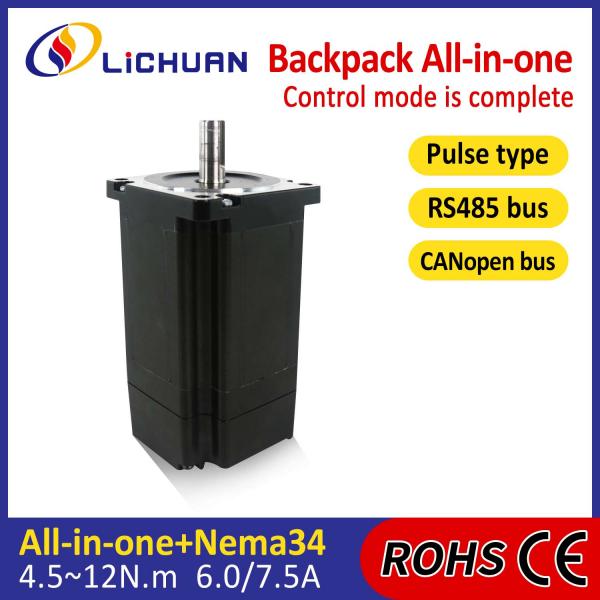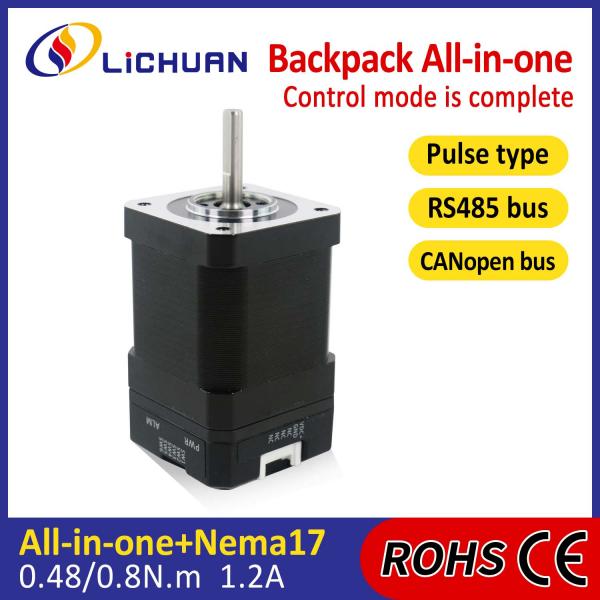
- English
- Español
- Português
- русский
- Français
- 日本語
- Deutsch
- tiếng Việt
- Italiano
- Nederlands
- ภาษาไทย
- Polski
- 한국어
- Svenska
- magyar
- Malay
- বাংলা ভাষার
- Dansk
- Suomi
- हिन्दी
- Pilipino
- Türkçe
- Gaeilge
- العربية
- Indonesia
- Norsk
- تمل
- český
- ελληνικά
- український
- Javanese
- فارسی
- தமிழ்
- తెలుగు
- नेपाली
- Burmese
- български
- ລາວ
- Latine
- Қазақша
- Euskal
- Azərbaycan
- Slovenský jazyk
- Македонски
- Lietuvos
- Eesti Keel
- Română
- Slovenski
- मराठी
- Srpski језик
When selecting automation equipment, what are the advantages of an integrated stepper motor over a standard stepper motor?
2025-10-15
When selecting automation equipment, many people struggle with the choice between an integrated stepper motor and a standard stepper motor. Standard stepper motors require separate drivers and cables, while integrated stepper motors integrate the motor, driver, and even the encoder. While this may seem like a reduction in components, the practical advantages are quite significant, especially for equipment that prioritizes efficiency and stability.

No need to purchase separate components, resulting in efficient installation
After selecting a standard stepper motor, you must also select a matching driver, find the appropriate cables, and find mounting brackets. Simply gathering these components is time-consuming. Furthermore, during installation, the motor and driver must be separately secured and carefully connected, which can lead to equipment malfunctions due to incorrect wiring. Integrated stepper motors directly integrate the motor and driver, and some even have built-in encoders, making them a one-stop solution. You don't have to worry about matching components when selecting a model; you can simply install it on the device. Wiring is also simple, often requiring only two wires: power and control signal. Unlike standard models, these require fewer motor and encoder cables.
Saves space and is suitable for compact designs
Many automated equipment, such as desktop 3D printers and small sorting robots, are becoming increasingly smaller and more compact, often requiring limited internal space. A standard stepper motor and driver combination requires two mounting locations and space for wiring harnesses, which can easily conflict with other components. An integrated stepper motor integrates all components into the motor body, making it comparable to, or even smaller than, a standard stepper motor. This eliminates the need for additional space for the driver, significantly saving internal space. For example, in a small labeling machine, an integrated motor can reduce the size of the device, making it easier to transport and position. Using a standard motor would either compress the space for other components or increase the size of the device, impacting the overall design.
Reduce Wiring Failures and Enhance Stability
Ordinary stepper motors have exposed motor and encoder cables. Misconnections and poor contact during installation are common. Furthermore, the wiring harness can become loose due to vibration during operation, causing the motor to lose steps or stall, impacting accuracy. Especially in dusty and vibrating workshops, the wiring harness is susceptible to wear and tear, increasing the likelihood of failure. The internal wiring of the Integrated Stepper Motor is pre-soldered at the factory, eliminating the need for complex external wiring harnesses and reducing potential wiring failure points. Furthermore, the integrated design better protects internal components, preventing dust from covering the driver and vibration from straining the wiring harness, resulting in more stable operation.

Simple Debugging, Even Novices Can Quickly Get Started
Common stepper motor debugging requires adjusting parameters such as subdivision, current, and decay mode on the driver, as well as repeatedly testing the motor's operating status. Improperly adjusted parameters can lead to motor overheating and lost steps, often leaving novice operators struggling for days. Most integrated stepper motors support debugging via software or external DIP switches, making parameter settings more intuitive. Some even come with preset parameters and ready-made parameter templates for different load scenarios. Simply select a template and use it, eliminating the need to start from scratch.
Lower overall cost and more cost-effective long-term use
Some people think that the higher unit price of an integrated stepper motor compared to a regular stepper motor might make it less cost-effective, but the overall cost is a different story. Regular stepper motors require separate drivers, cables, and mounting brackets, which can add up to more expensive costs than an integrated motor. Furthermore, installation and debugging are time-consuming and labor-intensive. Furthermore, regular motors have numerous wiring connections and components, requiring individual inspections during maintenance, which also increases maintenance costs. Integrated motors have fewer potential failure points, eliminating the need to disassemble numerous components during maintenance, saving both time and money.



